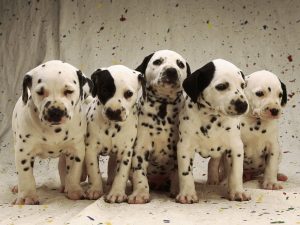Facts about Dalmatian Dogs
Dalmatians are distinctive medium to large-sized dogs known for their unique spotted coat and dignified appearance. Here’s an overview of Dalmatian dogs:
Appearance
Dalmatians have a well-muscled and athletic build with a square-shaped body and moderate bone structure. They typically weigh between 45 to 70 pounds (20 to 32 kg) and stand around 19 to 24 inches (48 to 61 cm) tall at the shoulder.
Their most distinctive feature is their short, dense coat, which is white with black or liver spots evenly distributed throughout the body. The spots are round and well-defined, giving the Dalmatian its unique appearance.
Dalmatians have a clean-cut head with a moderate stop and a long, tapering muzzle. They have dark, round eyes and ears that are set high and carried close to the head. The tail is of moderate length and tapers to a point.
Temperament
Dalmatians are known for their outgoing, friendly, and energetic temperament. They are social dogs that enjoy being part of the family and thrive on human companionship.
They are often described as playful and high-spirited, with a natural enthusiasm for life. Dalmatians are known for their boundless energy and love of activity, making them excellent companions for active individuals and families.
Dalmatians are intelligent and trainable but can be independent and strong-willed. Consistent training and positive reinforcement are important to channel their energy and prevent boredom or destructive behavior.

History
The exact origins of the Dalmatian breed are unclear, but they are believed to have originated in the region of Dalmatia, which is part of modern-day Croatia. They were historically used as carriage dogs, guard dogs, and hunting companions.
Dalmatians gained popularity in the 19th century as carriage dogs, trotting alongside horse-drawn carriages to protect them from highwaymen and other threats. They were also valued for their agility and stamina, which made them excellent coaching dogs.
Dalmatians became synonymous with firefighting in the United States in the early 20th century when they were used as firehouse mascots and carriage dogs for fire engines. Their association with firefighting continues to this day, and they are often seen as symbols of fire departments.
Popularity
21st Century: While Dalmatians remain a recognizable and beloved breed, their popularity has fluctuated over the years. The surge in demand following the release of “101 Dalmatians” led to concerns about overbreeding and irresponsible breeding practices, resulting in an influx of poorly bred and poorly socialized Dalmatian puppies. This, coupled with the breed’s high energy levels and tendency toward deafness, urinary stones, and other health issues, prompted some families to reconsider Dalmatians as pets.
Today, Dalmatians continue to be cherished for their distinctive appearance, playful personality, and loyal companionship. While they may not be as ubiquitous as they were during the peak of their popularity, Dalmatians still hold a special place in the hearts of many dog lovers and remain a popular choice for families seeking an active and affectionate companion.
Care
Dalmatians have a short, dense coat that requires regular brushing to remove dead hair and minimize shedding. They are moderate shedders year-round, with heavier shedding during seasonal changes.
Dalmatians are an active breed that requires regular exercise and mental stimulation to prevent boredom and maintain their physical and mental well-being. Daily walks, runs, or play sessions are essential to keep them happy and healthy.
Due to their high energy levels, Dalmatians may be prone to boredom-related behaviors such as excessive barking or digging if not provided with enough exercise and enrichment.
Dalmatians are generally healthy dogs, but they may be prone to certain health issues, including deafness, urinary stones, hip dysplasia, and skin allergies. Regular veterinary check-ups and a balanced diet are essential for maintaining their overall well-being.

Overall, Dalmatians are beloved for their distinctive appearance, playful personality, and loyal companionship. With proper care, training, and socialization, they make excellent family pets and companions for active individuals who can provide them with the exercise and attention they need.
More posts you might be interested in:

